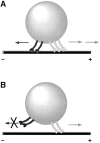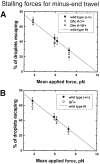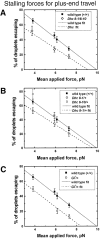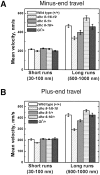Coordination of opposite-polarity microtubule motors
- PMID: 11854311
- PMCID: PMC2174082
- DOI: 10.1083/jcb.200109047
Coordination of opposite-polarity microtubule motors
Abstract
Many cargoes move bidirectionally, frequently reversing course between plus- and minus-end microtubule travel. For such cargoes, the extent and importance of interactions between the opposite-polarity motors is unknown. In this paper we test whether opposite-polarity motors on lipid droplets in Drosophila embryos are coordinated and avoid interfering with each other's activity, or whether they engage in a tug of war. To this end we impaired the minus-end transport machinery using dynein and dynactin mutations, and then investigated whether plus-end motion was improved or disrupted. We observe a surprisingly severe impairment of plus-end motion due to these alterations of minus-end motor activity. These observations are consistent with a coordination hypothesis, but cannot be easily explained with a tug of war model. Our measurements indicate that dynactin plays a crucial role in the coordination of plus- and minus-end-directed motors. Specifically, we propose that dynactin enables dynein to participate efficiently in bidirectional transport, increasing its ability to stay "on" during minus-end motion and keeping it "off" during plus-end motion.
Figures






References
-
- Blangy, A., L. Arnaud, and E.A. Nigg. 1997. Phosphorylation by p34cdc2 protein kinase regulates binding of the kinesin-related motor HsEg5 to the dynactin subunit p150. J. Biol. Chem. 272:19418–19424. - PubMed
-
- Fan, S.S., and D.F. Ready. 1997. Glued participates in distinct microtubule-based activities in Drosophila eye development. Development. 124:1497–1507. - PubMed
Publication types
MeSH terms
Substances
Grants and funding
LinkOut - more resources
Full Text Sources
Other Literature Sources
Molecular Biology Databases

